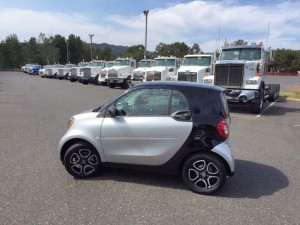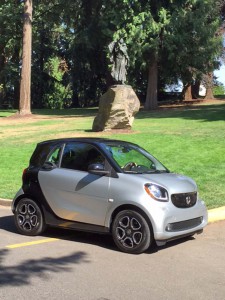Size matters. That’s long been a guiding principle in the U.S. auto industry, and with fuel prices down sharply this year, it seems truer than ever as American motorists once again shift from fuel-efficient small cars to larger SUVs, CUVs and pickups.
And that raises a serious question about this year’s launch of what will be the smallest car on the U.S. market, the 2016 Smart ForTwo. After a seemingly endless delay, parent Daimler AG has launched an all-new version of the microcar just as potential competitors, such as the Mini Cooper and Fiat 500 struggle to reverse double-digit sales declines.
Nonetheless, “We hope there is much more potential” for a brand that has so far failed to live up to its initial promise, says Annette Winkler, the head of the Smart brand during a first U.S. media drive of the new ForTwo model.
Originally conceived in 1994 as a joint venture between what was then Daimler-Benz AG and the Swiss watch company Swatch, Smart was targeted at buyers in crowded cities like Paris, Rome and New York, where streets are narrow, and parking spots are scarce and tight. To heighten its appeal, the partners also promised to encourage extensive customization by offering such features as swappable, multi-colored body panels.
By the time the first ForTwo hit the road in 1998, Swatch had pulled out of the project and the idea of easily replaceable body panels was abandoned. A U.S. launch, meanwhile, was repeatedly delayed, Smart crossing the Atlantic only in 2008 when the original microcar was already a decade old.
(Little Scion looking to add crossover to line-up. For more, Click Here.)
While sales in some crowded cities, notably Rome, surged, demand fell short of expectation in most other key European markets. Smart’s official U.S. debut was better timed, coming at a time when fuel prices were nudging record levels. That led to an initial burst of demand, sales nudging 20,000 in the first full year.
But what went up quickly tumbled back down, and the U.S. nosedive has continued into 2015. For the first seven months of the year, American buyers drove off with only 4,065 ForTwo microcars, a 32.2% decline. In July, sales totaled just 441, a year-over-year decline of 67.4%.
Weak demand globally forced Daimler to pull a number of Smart variants off the market. And with industry analysts estimating the German maker has so far lost more than $5 billion on the brand, it took an unusual route to develop a replacement for the original ForTwo, partnering with France’s Renault. A separate version of the microcar is being sold in many parts of the world as the Renault Twingo, shared development costs, the partners have bet, allowing them to make a profit in a notoriously money-losing segment.
(Big truck sales mean big industry profits. Click Here for more.)
The second-generation ForTwo has already gone on sale in Europe and other markets abroad, and sales for the brand overall have jumped 30%, to 71,450, for the first seven months of the year. That puts it on track to near, if not surpass, the record 140,000 Smart vehicles sold in one year a decade ago.
But whether the U.S. will keep pace is far from certain, cautions Dave Sullivan, senior auto analyst for AutoPacific, Inc., who stresses that, “Americans like to pay for their cars by the pound.”
At a base price of $15,400, including delivery charges, Sullivan noted, the German microcar is more expensive than some larger vehicles that still get the same, or even better, fuel economy than the 2016 Smart ForTwo. It is rated by the EPA at 36 mpg in the Combined cycle.
“That vehicle makes all the sense in the world in places like Rome,” says Sullivan. But the U.S. is another matter entirely.
Timing matters, or so goes another popular principle oft cited by automotive manufacturers. But while the 2016 Smart ForTwo’s arrival may coincide with cheap fuel, brand boss Winkler contends that there are other trends that could work in Smart’s favor. She points to the growing resurgence of urban living in the U.S. Smart is hoping to appeal to a subset of hip “individualists” who are abandoning suburbs – and the big cars long associated with suburban living.
Meanwhile, Smart is actively participating in the growth of carsharing programs. Little Smart cars with the Car2Go logo are frequent sights around Portland, among other select cities. The often eclectic city has embraced the ForTwo like few others in the U.S., with the brand doubling its presence in Portland over the past year.
While the U.S., overall, isn’t likely to match the 30% growth Smart has seen in the rest of the world this year, Winkler is hoping that the new ForTwo finally can reverse the brand’s tailspin and at least give it some positive momentum again.
It’s a long shot, insist analysts like Sullivan, and it would mark a major turnaround that even more successful small car brands like Mini haven’t been able to muster of late.
(Electronic synthesizer company Roland helps tune up a new battery sports car. Click Here for more.)



Even in our Italian hometown of Palermo, the cost mentioned in the story is an obstacle. Many of the Smart cars there are used cars from the north of Italy which are pretty beat up (which is the norm for cars in Palermo with it’s incredible traffic). Outside of the largest, and older with poor parking, cities in the US the Smart has a pretty difficult time finding a market. There are two in our city which are emblazoned with advertising, and two which are everyday drivers.
Does it still need premium gas? In any case, unless petrol goes above $4 in the US, big numbers are not gonna happen.
They need to gear for urban exclusively.
There is a reason why they are called the “NOT so Smart” cars and why people who are voting with their wallet do not buy them. Many people have significant safety concerns with these and other roller skate sized cars. According to recent industry reports those safety concerns are well founded. What would you expect a Smart car and it’s occupants to look like after a head on crash with an SUV?